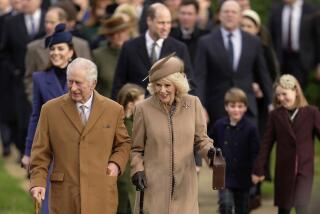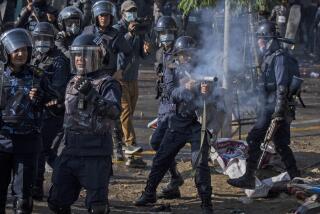Nepal’s crown prince is a royal liability
- Share via
KATMANDU, NEPAL — In this Himalayan nation, the man who would be king probably is the man who would be in jail if many of his subjects had their way.
Crown Prince Paras is heir to the throne in the world’s only Hindu-majority kingdom. But he is also the bad boy of the royal family, a ne’er-do-well whose careless driving killed a popular singer, whose drunken brawls are well-known and whose security detail had an entire wedding party detained for questioning after the prince’s car hit their bus.
For 238 years, Paras’ forefathers, the Shahs, have ruled Nepal, seemingly as immovable and lofty a fixture on the landscape as the surrounding mountains.
But history is catching up with the dynasty -- and may soon swallow it up entirely. This summer, capping a year of dizzying change, a special constitutional assembly is to be elected to redraw Nepal’s political map, which could see the monarchy eliminated.
That the country is teetering on the brink of a republican revolution is due in large part to the unpopularity of the crown prince’s father, King Gyanendra. Last year, opposition to a 15-month period of absolute royal rule helped unite pro-democracy activists, mainstream politicians and Maoist fighters in an alliance that forced the king to restore parliament, setting the stage for a peace accord between the reinstated government and the rebels.
It was a humiliating defeat for the king, who sits in his palace in the capital Katmandu waiting to learn his fate under the new constitution.
Practically all of the king’s powers already have been curtailed. Billboards with Gyanendra’s portrait have been torn down, his face has been ordered taken off the currency (to be replaced by Mt. Everest), a government committee has been formed to seize some of his assets, and the army and national airline have had the word “royal” struck from their names.
But as loathsome as the king is to many Nepalis, they despise his son even more.
Notorious for his boozing, his arrogant and bullying behavior and his frightening driving record, the 35-year-old prince has become so reviled that those who want to abolish the monarchy are, in many ways, as concerned with preventing Paras from ascending to the throne as removing his father from it.
“That would be totally bad,” said engineering student Arun Thapa, 19, grimacing at the prospect of a King Paras. “He’s a very corrupt person. He’s a vagabond, beating people up. He’s misused his powers a lot.”
To be fair, Paras Bir Bikram Shah Dev was never groomed to be next in line to the throne. For most of his life, he was a prince, but not the heir; the reigning monarch was his uncle, Birendra, and the expected successor was his cousin Dipendra.
But a freakish chain of events worthy of a Shakespearean tragedy thrust Paras into his role as king-in-waiting. In June 2001, Crown Prince Dipendra, apparently depressed over his parents’ disapproval of his girlfriend, went on a drunken shooting spree inside the palace, killing his parents and several other members of the royal family before turning his gun on himself. Paras and a few other relatives managed to escape unhurt.
Within days, Gyanendra, Birendra’s brother, was declared Nepal’s new king. Later that year, he named Paras as crown prince. But neither father nor son inspired much loyalty or confidence, having built reputations, respectively, as a profligate businessman and a bad-tempered layabout who roared around on the kingdom’s only Harley-Davidson and considered himself above the law.
Public dislike and distrust of that side of the royal family has been so strong that a large segment of society suspects that Gyanendra and Paras engineered the palace massacre in a power grab, despite official conclusions to the contrary.
“They were brothers, and brothers can be enemies also,” accountant Amrit Thapa (no relation to Arun) said of Gyanendra and the slain Birendra, “so it could be possible.”
By the time of his elevation, Paras was already reviled as the man who had run over and killed Praveen Gurung, a well-known singer, in August 2000. After crashing into Gurung in his father’s official car, apparently accidentally, Paras immediately sped over to the police station -- not to report the incident but to warn the officer on duty, at gunpoint, against doing so.
Public outrage ensued. But royal immunity kept the prince from being punished. It also had protected him a year earlier when he slammed the butt of a gun into the eye of a police officer who had dared to stop his car during a general strike.
In April 2006, only days after pro-democracy protests forced his father to relinquish total power, Paras made news again when his car ran into the wedding bus.
By tradition, the monarchy here has been considered the embodiment on Earth of the Hindu god Vishnu. But for many Nepalis, the current crown prince is more an emblem of royal misdeeds and excesses.
“I think he’s shot himself in the foot -- and at other people, too,” author Manjushree Thapa said.
“These individuals,” she added, speaking of Paras and his father, “they’ve done more for the republican agenda than the Maoists ever could.” Abolishing the monarchy is the Maoists’ prime objective.
The palace declined requests for an interview.
Since November’s peace agreement between the government and the rebels, the king and crown prince generally have kept a low profile.
When they have surfaced, it has been to further opprobrium. Last month, Gyanendra’s motorcade was stoned while on the way to a Hindu temple here in the capital. A few days later, the king was lambasted for issuing a statement defending his declaration of absolute rule in 2005, which he said was necessary to maintain public security during the Maoist insurgency.
Pockets of royalist sentiment still exist, often among older, more traditional Nepalis or among the religious.
“How can a house without elders be run?” said Beti Maya Maharjan, 60, drawing on a common analogy to describe the king’s paternalistic role.
Some politicians are seeking a compromise, such as retaining the monarchy as only a ceremonial institution.
Parliament already has announced that it will have the power to select any future king. If the monarchy does survive the constitutional assembly’s ax, there is widespread talk of bypassing Paras and putting his young son, Hridayendra, on the throne under the guidance of a regent -- anything, many Nepalis say, to make sure that the man who would be their king, won’t.
More to Read
Sign up for Essential California
The most important California stories and recommendations in your inbox every morning.
You may occasionally receive promotional content from the Los Angeles Times.











